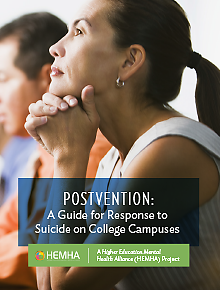APA Contributes to Guide for Suicide Response at Colleges
Abstract
APA teams with other organizations dedicated to student mental well-being to develop a guide to help colleges manage and move on from a suicide on campus.
When a tragic event like a suicide hits a community, most questions instinctively reflect back—“Why did this happen?” “What signs did we miss?” and perhaps most agonizingly, “How could we have prevented this?”
However, looking forward is a critical part of the process as well; a suicide needs to be properly acknowledged and managed to help a community move on.
It’s a strategy known as “postvention,” and it’s particularly important in places like college campuses, where a student’s suicide can strongly reverberate among a population that is young, vulnerable, and undoubtedly dealing with many stressors of its own.
“While none of us wants to experience a student suicide, it is an important reality of working on a campus,” said Leigh White, M.D., the chief of psychiatry services for Michigan State University Student Health.
The use of suicide postvention plans is becoming more prominent across colleges and universities, though there has not been much research in this area, forcing college officials to develop plans ad hoc from their own experiences.
“Colleges are well suited to manage a suicide in that they have an infrastructure to allow for a coordinated response in a way that a neighborhood community cannot,” said White, pointing to features such as on-campus security, counseling centers, and readily available ways to contact every student or his or her family.
“What many of us in this field realized was missing was some overarching guidance as to what college campuses should do to make best use of these resources.”

HEMHA’s suicide “postvention” guide is designed as both a campus planning tool and a useable guide for responding to a crisis situation.
White also serves as the APA representative to the Higher Education Mental Health Alliance (HEMHA), a consortium of groups dedicated to promoting mental well-being for students.
The result of HEMHA’s efforts to address this issue is Postvention: A Guide for Response to Suicide on College Campuses, a resource to help colleges more effectively and sensitively respond to campus deaths.
Published in November 2014, the postvention guide was designed to provide “actionable” guidance that colleges can adapt for their unique circumstances but is broad enough to be applicable to any campus environment from a tiny liberal arts college to a massive, multicampus state university.
And while the guide was envisioned as a planning tool, it was kept concise to enable it to be useable in a crisis if a suicide occurs at a college before a postvention strategy has been fully developed.
“Every suicide situation is unique, so this guide cannot provide a prescriptive set of best practices,” cautioned Victor Schwartz, M.D., the medical director for fellow HEMHA member the Jed Foundation, a nonprofit organization that works to promote mental health and prevent suicides in college students.
“However, the guide can identify specific intervention areas to target and offer suggestions for implementation strategies,” he added.
The key areas highlighted in the guide involve managing communications, providing proper clinical and support services, handling memorials and services, and getting back to the routine. Effective communication in particular can be complicated in a modern world where the facts—and rumors—regarding a suicide can spread rapidly via social media.
Schwartz noted that HEMHA will make the guide a downloadable online resource and treat it as a living document that can be updated as schools implement the recommendations and provide feedback on effective approaches.
Critically, noted White, a commitment to postvention does not diminish campus efforts to prevent suicides from occurring. “One of the biggest worries following a suicide is suicide contagion spreading through the campus and affecting other vulnerable people,” she told Psychiatric News. “And the HEMHA guide specifically addresses this risk and how to limit it. So if done properly, a postvention strategy is also a prevention strategy,” she said.
In addition to APA and the Jed Foundation, other HEMHA members that helped develop this guide include the American College Counseling Association, American College Health Association, American College Personnel Association, American Psychological Association, Association for University and College Counseling Directors, and NASPA-Student Affairs Administrators in Higher Education. ■
“Postvention: A Guide for Response to Suicide on College Campuses” can be accessed here. This site also contains HEMHA’s previous guide, “Balancing Safety and Support on Campus.”



